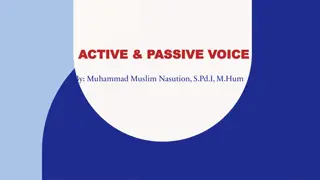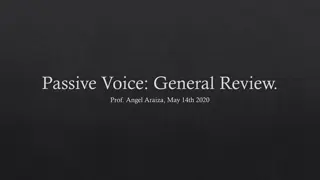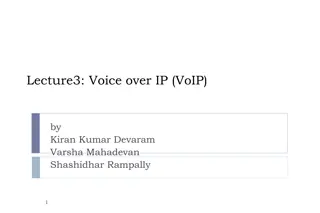Exploring the Power of Voice in Media and Art
Delve into the significance of disembodied voices, unique perspectives by scholars like Adriana Cavarero and Jacques Derrida, and the interplay between voice, truth, and subjectivity in Western traditions. Uncover the complexities of vocality in various cultural contexts and cinematic representations, along with feminist film theories dissecting the Hollywood sonic landscape. Dive into the essence of sound, art, and power in understanding the voice's role in shaping consciousness and identity.
Download Presentation

Please find below an Image/Link to download the presentation.
The content on the website is provided AS IS for your information and personal use only. It may not be sold, licensed, or shared on other websites without obtaining consent from the author. Download presentation by click this link. If you encounter any issues during the download, it is possible that the publisher has removed the file from their server.
E N D
Presentation Transcript
SOUND, ART, & POWER Week 3: Voice in Media Disembodied Voices
Unique (Adriana Cavarero)
pure auto-affection (Jacques Derrida)
the stuff of consciousness. (Jonathan Sterne)
The voice and nothing more. (Mladen Dolar)
Two powerful ideas about the voice in the Western metaphysical and linguistic traditions:
Two powerful ideas about the voice in the Western metaphysical and linguistic traditions: 1. Voice as the guarantor of truth and self- presence (the voice expresses self and identity; subjectivity)
Two powerful ideas about the voice in the Western metaphysical and linguistic traditions: 1. Voice as the guarantor of truth and self- presence (the voice expresses self and identity; subjectivity) 2. The sounding, material voice (material vocality)
Voice in Media: Theories of the voice (liberation movements, identity politics, subject formation psychoanalysis, feminism) Chion: There are voices, and then everything else. (The Voice in Cinema, p. 5) Vococentrism Verbocentrism Synchronization
Voice & Disembodiment: Power of the disembodied voice (Connor, Chion, Doane and Bonitzer) Schizophonia (Schafer) History (Altman) Feminist film theory (Silverman, Doane)
According to Silverman, Hollywoods sonic vraisemblable, codified in its standards and conventions, stresses unity and anthropomorphism. It subordinates the auditory to the visual track, nonhuman sounds to the human voice, and noise to speech. It also contains the human voice within the fiction or diegesis .
Silverman further points out that sonic vraisemblable is sexually differentiated, where a complex system of displacements which locate the male voice at the point of apparent textual origin, while establishing the diegetic containment of the female voice .
In The Acoustic Mirror, she argues that the stress points in Hollywood cinema, where the impression of reality through sound begins to unravel, are symptoms not unlike the involuntary speech or actions a patient exhibits under psychoanalysis that are indicative of the cultural illusion or fantasies covering up, repressing, or disavowing the instability and loss inherent in the process of subject formation.
And these illusions and fantasies are usually enacted upon the bodies of women in film. (TINST, p. 30)
Disembodied Voices: 1. Radical otherness As soon as the sound is detached from its source, no longer anchored by a represented body, its potential work as a signifier is revealed. There is always something uncanny about a voice which emanates from a source outside the frame. (Doane, p. 166)
Disembodied Voices: 1. Radical otherness As soon as the sound is detached from its source, no longer anchored by a represented body, its potential work as a signifier is revealed. There is always something uncanny about a voice which emanates from a source outside the frame. (Doane, p. 166)
Disembodied Voices: 1. Radical otherness It is its radical otherness with respect to the diegesis which endows this voice with a certain authority. (Doane, p. 168)
Disembodied Voices: 1. Radical otherness It is its radical otherness with respect to the diegesis which endows this voice with a certain authority. (Doane, p. 168)
Disembodied Voices: 1. Radical otherness As a form of direct address, it speaks without mediation to the audience, bypassing the characters and establishing a complicity between itself and the spectator together they understand and thus place the image.
Disembodied Voices: 1. Radical otherness Disembodied, lacking any specification in space or time, the voiceover is, as Bonitzer points out, beyond criticism it censors the questions Who is speaking? , Where? , In what time? , and For Whom? (Doane, p. 168)
Disembodied Voices: 1. Radical otherness Disembodied, lacking any specification in space or time, the voiceover is, as Bonitzer points out, beyond criticism it censors the questions Who is speaking? , Where? , In what time? , and For Whom? (Doane, p. 168)
Disembodied Voices: 1. Radical otherness Because it rises from the field of the Other, the voice-off is assumed to know: this is the essence of its power The power of the voice is a stolen power, a usurpation. (Bonitzer, Cahiers du Cin ma, p. 26)
Disembodied Voices: 1. Radical otherness Because it rises from the field of the Other, the voice-off is assumed to know: this is the essence of its power The power of the voice is a stolen power, a usurpation. (Bonitzer, Cahiers du Cin ma, p. 26)
Disembodied Voices: 1. Radical otherness 2. Picture lecturers / Montreur d images / Conf rencier
John L. Stoddard (Career: 1879-1897) E. Burton Holmes (First lecture in 1890, designated as Stoddard s successor in 1897)
Picture lecturers like Stoddard and Holmes: Were active from 1890s to 1950s Conf rencier (educator, quasi-academic figures), bonimenteur ( bonus-liar , explains and narrates existing films) Used a mixture of photographs, hand-painted slides and reproduction of drawings or engravings Made the first documentaries
Since the dawn of time, voices have presented images, made order of things in the world, brought things to life and named them. (Chion, The Voice in Cinema, p. 49) Instead of simply repeating what the image say, the lecturer has the power to make the audience perceive something other than what the images actually show. The power of the lecturers lies not so much in their ability to explain the visual, but in the power to redefine the images according to an alternate set of values. (Altman, Silent Film Sound, pp. 71-72)
Since the dawn of time, voices have presented images, made order of things in the world, brought things to life and named them. (Chion, The Voice in Cinema, p. 49) Instead of simply repeating what the image say, the lecturer has the power to make the audience perceive something other than what the images actually show. The power of the lecturers lies not so much in their ability to explain the visual, but in the power to redefine the images according to an alternate set of values. (Altman, Silent Film Sound, pp. 71-72)
News from Home (1976) Dir. Chantal Akerman
Surname Viet Given Name Nam (1989) Dir. Trinh T. Minh-ha
Autoethnography Self-fashioning (James Clifford)
Autoethnography Self-fashioning (James Clifford) An ideal form of antidocumentary (Catherine Russell)
Autoethnography Self-fashioning (James Clifford) An ideal form of antidocumentary (Catherine Russell) Disidentification (Jos Mu oz)
Autoethnography Fran oise Lionnet s definition: the defining of one's subjective ethnicity as mediated through language, history, and ethnographical analysis (Quoted in TINST, p. 32) a kind of figural anthropology of the self it opens up a space of resistance between the individual (auto-) and the collective (- ethno-) where the writing (-graphy) of singularity cannot be foreclosed .
Autoethnography Fran oise Lionnet s definition: the defining of one's subjective ethnicity as mediated through language, history, and ethnographical analysis (Quoted in TINST, p. 32) a kind of figural anthropology of the self it opens up a space of resistance between the individual (auto-) and the collective (- ethno-) where the writing (-graphy) of singularity cannot be foreclosed .
Autoethnography This term refers to instances in which colonized subjects undertake to represent themselves in ways that engage with the colonizer s terms. Autoethnography involves partly collaborating with and appropriating the idioms of the conqueror (9) Autoethnographic texts are typically heterogeneous on the reception end (All from Mary Louise Pratt, Imperial Eyes, p. 9)
Autoethnography This term refers to instances in which colonized subjects undertake to represent themselves in ways that engage with the colonizer s terms. Autoethnography involves partly collaborating with and appropriating the idioms of the conqueror (9) Autoethnographic texts are typically heterogeneous on the reception end (All from Mary Louise Pratt, Imperial Eyes, p. 9)
Autobiography becomes ethnographic at the point where the film- or videomaker understands his or her personal history to be implicated in larger social formations and historical processes.
Identity is no longer a transcendental or essential self that is revealed, but a staging of subjectivity - a representation of the self as a performance. In the politicization of the personal, identities are frequently played out among several cultural discourses, be they ethnic, national, sexual, racial, and/or class based.
Identity is no longer a transcendental or essential self that is revealed, but a staging of subjectivity - a representation of the self as a performance. In the politicization of the personal, identities are frequently played out among several cultural discourses, be they ethnic, national, sexual, racial, and/or class based.
The subject in history is rendered destabilized and incoherent, a site of discursive pressures and articulations. (Russell, Experimental Ethnography, p. 276)
autoethnographic performances by queers of color insert a subjective, performative, often combative, native I into ethnographic film s detached discourse (Mu oz quoted in TINST, p. 33)
autoethnographic performances by queers of color insert a subjective, performative, often combative, native I into ethnographic film s detached discourse (Mu oz quoted in TINST, p. 33)























